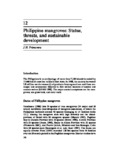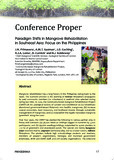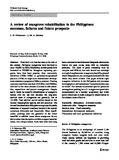Philippine mangroves: status, threats and sustainable development
Share
Abstract
The status of the Philippine mangroves is examined, the functions of mangrove areas are highlighted, the threats to mangrove resources are identified, and the prospects for sustainable use are discussed. The Philippines harbour 39 species of true mangroves belonging to the following genera: Acanthus, Camptostemon, Lumnitzera, Excoecaria, Pemphis, Xylocarpus, Aegiceras, Osbornia, Nypa, Aegialitis, Bruguiera, Ceriops, Kandelia, Rhizophora, Scyphiphora, and Sonneratia. The fauna is equally diverse. Apart from fish and shrimp, other animals collected from mangroves are crabs and lobsters, bivalve and gastropod molluscs, and other invertebrates. Mangrove services include coastal protection, erosion control, sediment stabilization, flood regulation, nutrient supply and regeneration, waste treatment, and wildlife habitats. Mangroves could be valuated at around 10,000 US$/ha/year. As elsewhere, it can be expected that the net present value is highest if the mangrove cover is maintained. The decline of mangroves from about 500,000 ha in 1918 to only 120,500 ha in 1994 was caused by overexploitation by coastal dwellers and to conversion to settlements, agriculture, aquaculture, salt pans, and industry. The remaining mangroves should be conserved. It is recommended to establish the following zones: (1) protected forest; (2) productive forest; (3) reforestation areas; and (4) conversion areas.
Suggested Citation
Primavera, J. H. (2004). Philippine mangroves: status, threats and sustainable development. In M. Vannucci (Ed.), Mangrove Management and Conservation: Present and Future (pp. 192–207). Tokyo, Japan: United Nations University Press.
Subject
Taxonomic term
Collections
Related items
Showing items related by title, author, creator and subject.
-
Field guide to Philippine mangroves
Primavera, Jurgenne (Zoological Society of London-Philippines, 2009)Awareness of mangrove importance, particularly for coastal protection, has grown among the general public over the past several years. In turn, this has led to numerous planting initiatives by various groups. However, most ... -
Paradigm shifts in mangrove rehabilitation in Southeast Asia: Focus on the Philippines
Primavera, Jurgenne H.; Guzman, Armi May T.; Coching, Jofel D.; Loma, Rona Joy A.; Curnick, David; Koldewey, Heather J. (Department of Environment and Natural Resources - Ecosystems Research and Development Bureau (DENR-ERDB), 2014)Mangrove rehabilitation has a long history in the Philippines dating back to the 1930s. The standard practice is the planting of bakhaw Rhizophora propagules by paid community members (or volunteers) in seafront sites ... -
A review of mangrove rehabilitation in the Philippines: successes, failures and future prospects
Primavera, Jurgenne; Esteban, J. M. A. (Springer, 2008)From half a million hectares at the turn of the century, Philippine mangroves have declined to only 120,000 ha while fish/shrimp culture ponds have increased to 232,000 ha. Mangrove replanting programs have thus been ...






